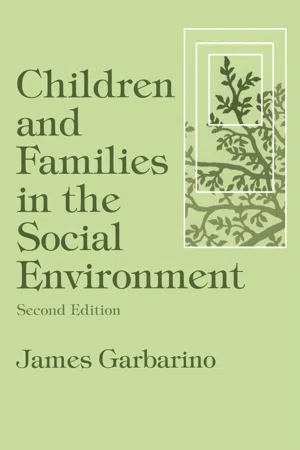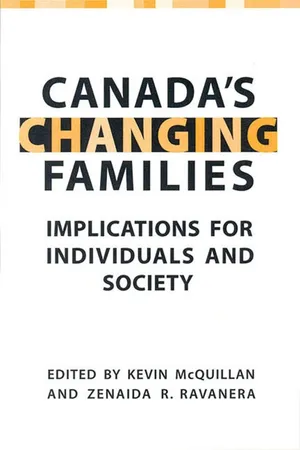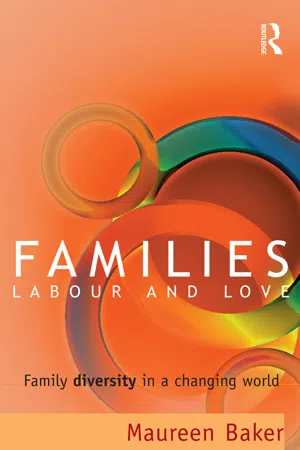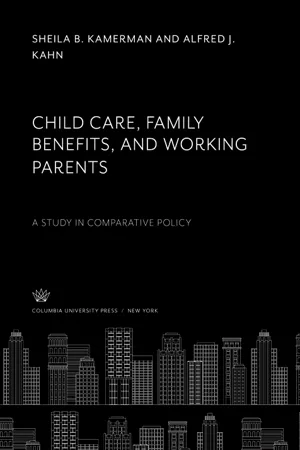Social Sciences
Child-Bearing
Child-bearing refers to the process of giving birth and raising children. It encompasses the physical, emotional, and social aspects of reproduction and parenting. In the social sciences, child-bearing is studied in relation to family structures, gender roles, and societal norms, as well as its impact on individuals and communities.
Written by Perlego with AI-assistance
Related key terms
1 of 5
4 Key excerpts on "Child-Bearing"
- eBook - ePub
Children and Families in the Social Environment
Modern Applications of Social Work
- James Garbarino(Author)
- 2017(Publication Date)
- Routledge(Publisher)
6The Ecology of Childbearing and Child Rearing Garbarino James and L. Benn Joanne There are two lasting bequests we can give our children— one is roots, the other wings. AnonymousThe decision to accept the responsibilities of parenthood is a bold confrontation between dreams and doubts, between past and future. This chapter uses the ecological perspective to examine the social and psychological aspects of becoming and sustaining a healthy family. Beginning with childbirth as a critical life event, we explore the importance of active parent participation in decisions affecting child development and family life. Important variations in childbirth practices across cultural and historical contexts form the basis for discussing basic issues in parent-child relationships from childhood through adolescence. All those concerned with optimizing the potential of our youngest generation must appreciate the monumental task of maintaining the delicate balance of supports and challenges that give children both roots and wings.Childbearing: Birth of the Parent-Child Relationship
A baby emerges from the protection of the mother’s womb into a new environment. Without the buffering influence provided by the prenatal home, the newborn must adjust to bombardment by the sensations of light, sound, and temperature change. The baby’s parents, too, are encountering profound changes. For the mother, the final stages of labor and delivery mark the culmination of more than 9 months of bodily changes to accommodate the growing fetus. For both parents, the delivery is another important phase in the psychological and social preparation for becoming a parent. Bronfenbrenner (1979) calls these life changes ecological transitions.Defined as alterations in an individual’s position in the environment resulting from a change in role or setting, ecological transitions are numerous during pregnancy and childbirth. Examples of transitional events experienced by most parents during the perinatal period include entering the birth setting, seeing and touching the newborn for the first time, and taking the neonate home. Together, this cluster of activities and associated role changes defines and gives meaning to the birth experience as a critical life event that can affect profoundly both newborn and parents for the remainder of their lives. - eBook - PDF
- Kevin McQuillan, Zenaida R Ravanera(Authors)
- 2017(Publication Date)
- University of Toronto Press(Publisher)
2 Transformed Families and the Basis for Childbearing roderic beaujot and ali muhammad One of the most significant family changes is in terms of numbers of children. Given the importance of childbearing to individuals, to the demographic reproduction of society, and to the relative size of age groups, much attention is placed on observing and interpreting the trends. Childbearing can be viewed in terms of the desires that people have, and the constraints under which they operate. There is debate in the lit-erature with regard to the relative importance of economic and cultural questions in influencing fertility change. Caldwell (1997) develops a ‘unifying theory’ based both on the changed socioeconomic circum-stances of people’s lives, and changing ideas and norms on appropriate family behaviour. Axinn and Yabiku (2001) propose that cultural con-siderations operate in terms of desires to have children, while economic considerations are more relevant to the constraints on childbearing. In theorizing about low fertility, McDonald (2002) proposes that there is considerable desire for children, as seen through childbearing intentions, but the risks and uncertainties of a globalizing world make people hesitate to have children. A globalizing world probably pro-duces more risks that are partly handled through stronger investment in one’s own human capital, leaving less time for reproduction. There is also a heightened awareness of risk, along with sustained efforts to manage and control it (Hall 2002). People may feel that their relation-ships are insufficiently secure to have children, they may feel insecure in the labour market, or they may feel a lack of support from the broader society, in terms of childcare and other services for families. Relationships, childbearing, and work can thus be theorized in terms of life strategies for optimizing lifetime welfare. At the individual level, - eBook - ePub
Families, Labour and Love
Family diversity in a changing world
- Maureen Baker(Author)
- 2020(Publication Date)
- Routledge(Publisher)
Historians have begun to pay greater attention to children’s contributions to families while social psychologists continue to study early childhood development. Sociologists have tended to focus on the adults in families rather than the children (Eichler 1988, p. 58) and have glossed over other important issues, such as how the experience of childhood has changed from the viewpoint of children, their parents and the state. In recent decades, however, a number of sociologists have studied how children influence their parents’ behaviour (Ambert 1990, 1992), reasons for and against Child-Bearing (Veevers 1980, Cameron 1990, 1997), children and the state (Jamrozik and Sweeney 1996), and theorised about children born through new reproductive technologies (Eichler 1996). Despite these investigations, sociologists have tended to view ‘the family’ as a unit and have overlooked the fact that children may have divergent needs and views from their parents.PARENTHOOD, REFLECTION AND CHOICEIn all three countries, marriage and reproduction within marriage have been associated with maturity, responsibility and the ‘normal’ adult lifestyle. Increasingly, however, whether or not to marry and reproduce are becoming choices for a greater number of people. These choices are allowed by more effective contraceptives, legalised abortion, changing attitudes about alternative lifestyles and more options for women to support themselves through paid work (Renvoize 1985). Despite these options, most people marry at least once and bear children (McDaniel and Tepperman 2000, p. 24).Access to safe and reliable contraception is not the only determinant of Child-Bearing decisions. Political economists remind us that fertility choices may also reflect the declining economic value of children, higher expectations of living standards, pressures on women to contribute to the family income, women’s educational and employment aspirations, and life alternatives. Fertility is also influenced by cultural and personal ideals about family size and the timing of births, perceptions of marital stability, and the costs and benefits of reproduction with a particular person in a specific culture or society (Callan 1982a, p. 387).Research from many countries indicates that most adults who become parents do so as a matter of course, without much reflection. Those who do not reproduce are either unable to, for physiological or situational reasons, or choose not to. People who decide not to reproduce tend to weigh the advantages and disadvantages and discuss the issues at some length with their partner, family or friends before finalising their decision (Ramu and Tavuchis 1986, Cameron 1997). Researchers have focused on two main explanations for why so many people continue to reproduce, despite the hardships. One relates to social expectations and pressures, and is derived from structural functionalism, and the other emphasises cost/benefit analysis, and is derived from both social exchange theory and the political economy perspective. - eBook - PDF
Child Care, Family Benefits, and Working Parents
A Study in Comparative Policy
- Sheila B. Kamerman, Alfred J. Kahn(Authors)
- 2019(Publication Date)
- Columbia University Press(Publisher)
It is within this context that we discuss the developments in six coun-tries experiencing these changes, and analyze the implications for the in-dustrialized world in general. 2 WORKING PARENTS Childbearing and child rearing continue to be the core functions of the family in our society, and child care continues to be the most important family responsibility carried by employed women. If women are to bear and rear children at the same time as they participate in the labor force, traditional assumptions regarding women bearing sole or primary responsi-bility for child care and child rearing become increasingly untenable. Even as there is more shared responsibility between husbands and wives, the pressures on the time and energy of working parents-and especially on single parents—increasingly demonstrates the need for some sort of response and adaptation by the society at large as well. The question of what this response should be has already emerged as a central issue in family—or social—policy in many countries. The primary source of concern may vary. There may be worry about the decline in birth rates as women enter the labor force. An anticipated decline in pop-ulation may lead to apprehension regarding the growing burden of retire-ment and old-age pensions on a contracting productive population. There may be interest in encouraging or discouraging (depending on the country) work by women. There may be some desire to assure women greater equality with men. There may be a search for improved approaches to child development and socialization, or for ways to improve the quality of life for all. Efforts at addressing any or all of these concerns must be balanced against problems of resource limitations and scarcity. Yet whichever con-cern is primary, the problem of caring for the very young child touches them all.
Index pages curate the most relevant extracts from our library of academic textbooks. They’ve been created using an in-house natural language model (NLM), each adding context and meaning to key research topics.



